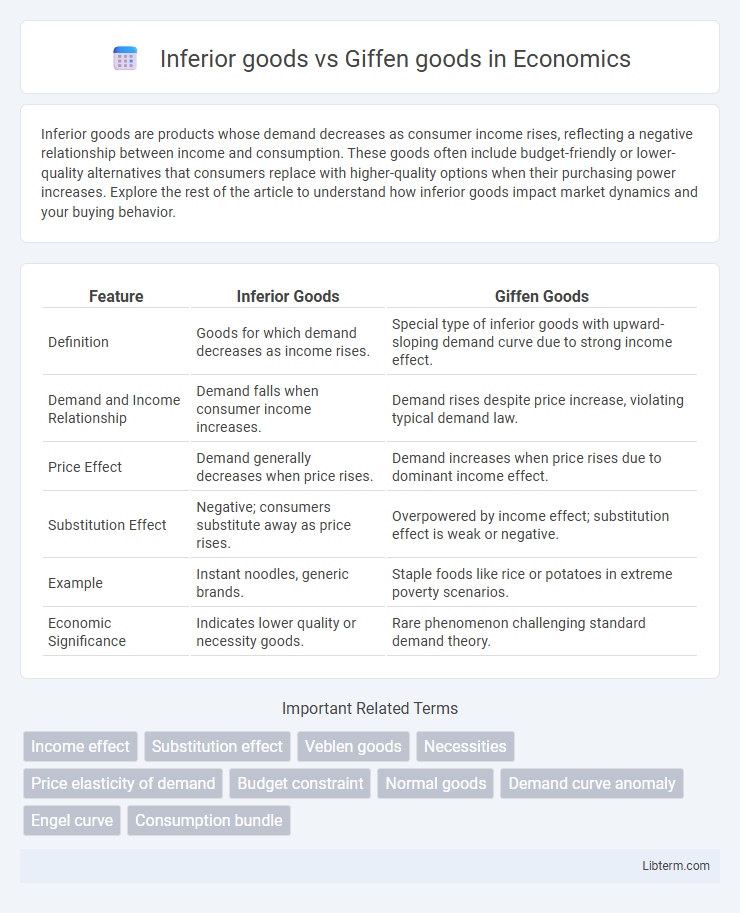Inferior goods are products whose demand decreases as consumer income rises, reflecting a negative relationship between income and consumption. These goods often include budget-friendly or lower-quality alternatives that consumers replace with higher-quality options when their purchasing power increases. Explore the rest of the article to understand how inferior goods impact market dynamics and your buying behavior.
Table of Comparison
| Feature | Inferior Goods | Giffen Goods |
|---|---|---|
| Definition | Goods for which demand decreases as income rises. | Special type of inferior goods with upward-sloping demand curve due to strong income effect. |
| Demand and Income Relationship | Demand falls when consumer income increases. | Demand rises despite price increase, violating typical demand law. |
| Price Effect | Demand generally decreases when price rises. | Demand increases when price rises due to dominant income effect. |
| Substitution Effect | Negative; consumers substitute away as price rises. | Overpowered by income effect; substitution effect is weak or negative. |
| Example | Instant noodles, generic brands. | Staple foods like rice or potatoes in extreme poverty scenarios. |
| Economic Significance | Indicates lower quality or necessity goods. | Rare phenomenon challenging standard demand theory. |
Introduction to Inferior Goods and Giffen Goods
Inferior goods are products whose demand decreases as consumer income rises, reflecting a negative income elasticity of demand, typically including items like generic brands or public transportation. Giffen goods represent a rare subset of inferior goods where demand paradoxically increases as their price rises, due to the strong income effect outweighing the substitution effect. Understanding these distinctions is crucial in economic analysis, as Giffen goods challenge traditional demand theory by exhibiting upward-sloping demand curves.
Defining Inferior Goods: Key Characteristics
Inferior goods are products whose demand decreases as consumer income rises, indicating a negative income elasticity of demand. Key characteristics include affordability and substitution effect, where consumers switch to higher-quality alternatives when their purchasing power improves. These goods typically represent basic or lower-cost items, unlike Giffen goods which paradoxically see demand increase with rising prices due to the strong income effect outweighing the substitution effect.
Understanding Giffen Goods: Anomaly in Economics
Giffen goods represent an economic anomaly where demand increases as prices rise, defying the typical law of demand observed in inferior goods. Unlike standard inferior goods, Giffen goods exhibit a strong income effect that outweighs the substitution effect, causing consumers to purchase more despite higher prices. This paradox primarily occurs in essential commodities with limited substitutes, highlighting the complex interplay between income, price changes, and consumer behavior in microeconomic theory.
Major Differences Between Inferior and Giffen Goods
Inferior goods experience a decrease in demand as consumer income rises, while Giffen goods are a specific type of inferior good where demand increases as price rises due to the strong income effect outweighing the substitution effect. Unlike typical inferior goods, Giffen goods violate the basic law of demand because higher prices lead to higher quantity demanded. The major difference lies in consumer behavior: inferior goods show negative income elasticity, whereas Giffen goods demonstrate a positive price elasticity of demand despite being inferior.
Causes Behind Inferior Goods Demand
Inferior goods experience increased demand when consumer incomes decline, as individuals opt for cheaper alternatives to maintain consumption. This shift is driven by changes in purchasing power and consumer preferences under budget constraints. Unlike Giffen goods, which exhibit a paradoxical rise in demand due to the strong income effect overpowering the substitution effect, inferior goods generally see higher demand solely from reduced income levels without the inversion in substitution behavior.
The Giffen Paradox Explained
Giffen goods represent a rare category of inferior goods exhibiting a positive price-demand relationship, defying the basic law of demand. The Giffen paradox occurs when a price increase for a staple food item, such as bread or rice, leads to higher consumption among low-income consumers because the income effect outweighs the substitution effect. This phenomenon highlights the complex interplay between income elasticity and consumer behavior in poverty-stricken markets.
Real-World Examples of Inferior Goods
Inferior goods are products for which demand decreases as consumer income rises, such as instant noodles, bus rides, and generic brand groceries commonly seen in lower-income households. In contrast, Giffen goods, a rare subset of inferior goods, see demand increase as prices rise due to the strong income effect outweighing the substitution effect, exemplified historically by staple foods like potatoes during the Irish Potato Famine. Understanding these distinctions helps economists analyze consumer behavior patterns in different income brackets and market conditions.
Case Studies: Famous Giffen Goods Incidents
Famous Giffen goods incidents include the 19th-century Irish Potato Famine, where potatoes acted as a Giffen good as their price rose, increasing consumption among impoverished families who had no affordable substitutes. Another case involved rice in certain regions of China, where price hikes led to higher consumption by low-income households due to the lack of alternative staples. These case studies highlight the unique economic behavior distinguishing Giffen goods from inferior goods, where demand paradoxically rises as prices increase.
Economic Implications of Inferior and Giffen Goods
Inferior goods typically see decreased demand as consumer income rises, impacting market strategies and welfare analysis by reflecting shifts in purchasing power. Giffen goods, a subset of inferior goods with upward-sloping demand curves, challenge conventional demand theory, causing paradoxical increases in quantity demanded despite price hikes. Understanding these goods aids in designing targeted fiscal policies, predicting consumer behavior during economic fluctuations, and addressing poverty-related consumption patterns effectively.
Conclusion: Inferior Goods vs Giffen Goods in Consumer Behavior
Inferior goods experience a decrease in demand as consumer income rises, reflecting a typical negative income effect, while Giffen goods exhibit an unusual positive demand response despite higher prices due to a dominant income effect outweighing substitution. Consumer behavior towards inferior goods aligns with conventional economic models, whereas Giffen goods challenge standard assumptions by defying the law of demand. Understanding these differences is essential for accurately predicting market reactions and designing effective economic policies.
Inferior goods Infographic

 libterm.com
libterm.com